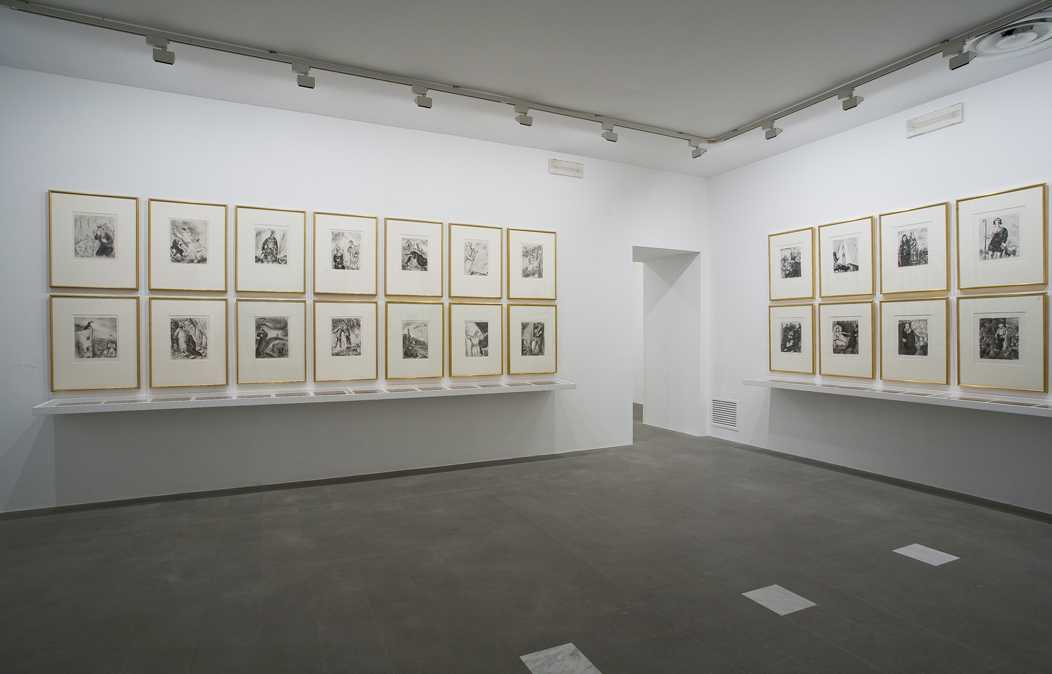Monsters, chimeras and hybrid figures
Mysterious chimeras, half-man, half-beast, composite objects with human heads and imaginary flying animals run through Marc Chagall’s entire work. For the first time an exhibition is entirely dedicated to them. Certainly Chagall had the opportunity to get to know these hybrid beings by observing the demons of the icons and the compositions derived from the medieval sculpture of his native country, which the artist deeply admired. Chagall was also struck by Goya’s Capricci series, where man often takes on the features of a donkey. More generally, hybridity, perceptible throughout the history of art, influenced Marc Chagall’s imagination.
In this sense, the artist places himself in a tradition that includes famous works such as the Issenheim altarpiece, the compositions of Jérôme Bosch or Johann Füssli. Some of his contemporaries try to fit into this same tradition. In fact, from Picasso to Brancusi, from Hans Arp to Victor Brauner, winged quadrupeds, bird-women and other more or less attractive monsters dot the production of the 20th century.
In Chagall’s iconography, hybridization finds its recurring figures: the human head is replaced by an animal head, the beasts have human limbs which they use to play music or paint; in the same way, arms and heads emerge from the cellos painted by Chagall and the instruments play their melody by themselves.
What meaning can we attribute to these beings? Beyond the symbolic or metaphorical dimension, the religious aspect, linked to the Hasidic traditions of the Vitebsk region, the artist’s hometown, cannot be excluded. Furthermore, the omnipresence of domestic animals such as the cow, the goat, the rooster, brings back memories of a childhood in the company of these beasts. The artist’s uncle, a butcher by profession, killed the cows by whispering words of comfort to them. The goat playing the violin brings to mind the enchanting parties enlivened by the sweet notes of the walking violinist. The fish recalls the figure of his father, a herring seller. And even the singing of birds, which play the violin or the shofar, is similar to divine music.
With the humor that distinguishes him, the artist does not hesitate to take on bestial guise, portraying himself with the features of a rooster or a goat, an animal for which the artist has repeatedly expressed his affection and compassion. Even the donkey, a humble but at the same time messianic beast, is depicted here as a possible image of the artist.
These composite figures are therefore always the sign of a poetic synthesis, which allows us to see these different levels of representations in a single image. In 1941 André Breton argued that, with Chagall, metaphor had made its entry into 20th century painting. He also underlined the ability that the painter had to “free the object from the laws of heaviness, to break down the barrier of the elements and kingdoms” and to translate, into a plastic language, the restless traces of the dream as well as the essence of beings and things.
Biblical themes
Chagall always had the themes linked to Judaism and the Bible at heart: «It has always seemed to me and still seems to me that the Bible is the main source of poetry of all time […] it was the colored alphabet in which I dipped my brushes in.” The whole Bible is the great code, that is, the essential point of reference of our culture, it is the polar star towards which everyone, believers and non-believers, has oriented themselves when they have searched for the beautiful, the true and the good, perhaps also to reject this driving and wandering elsewhere.
When, in 1930, the art dealer and publisher Ambroise Vollard proposed that he illustrate the sacred book of Judaism (a titanic undertaking which, after Rembrandt, was no longer attempted by any artist), Chagall accepted with understandable enthusiasm and humility. But before starting work, in 1931 he embarked for Palestine. It was not only a spiritual experience, a pilgrimage or a return to the land of origin, but also a plastic experience: he discovered the parched, essential landscapes, immersed in a dazzling light.
The biblical scenes, centered on the theme of Man as a creature of God, are pictures of the life of a Jewish village of those times and therefore connected to a present, to an everyday life, of which Chagall’s art manages to reveal the mystery: «Chagall reads the Bible and immediately the biblical passages become light for everyone», wrote the philosopher Gaston Bachelard in this regard.
Thus, Marc Chagall’s works free themselves from the restrictive confessional value, overcome the narrow limits of representation of the Jewish religion, to embrace and acquire a universal spiritual and poetic meaning, specific to every man and every time.

